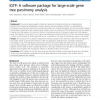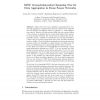112 search results - page 11 / 23 » The Performance of Phylogenetic Methods on Trees of Bounded ... |
BMCBI
2010
13 years 7 months ago
2010
Background: The ever-increasing wealth of genomic sequence information provides an unprecedented opportunity for large-scale phylogenetic analysis. However, species phylogeny infe...
JCB
2000
13 years 7 months ago
2000
Multiple sequence alignments (MSAs) are frequently used in the study of families of protein sequences or DNA/RNA sequences. They are a fundamental tool for the understanding of th...
DCOSS
2006
Springer
13 years 11 months ago
2006
Springer
Abstract. Today, there exist many algorithms and protocols for constructing agregation or dissemination trees for wireless sensor networks that are optimal (for different notions o...
BMCBI
2008
13 years 7 months ago
2008
Background: It has repeatedly been shown that interacting protein families tend to have similar phylogenetic trees. These similarities can be used to predicting the mapping betwee...
JACM
2006
13 years 7 months ago
2006
Abstract. Maximum likelihood (ML) is an increasingly popular optimality criterion for selecting evolutionary trees [Felsenstein 1981]. Finding optimal ML trees appears to be a very...



